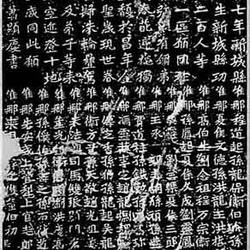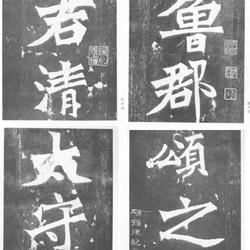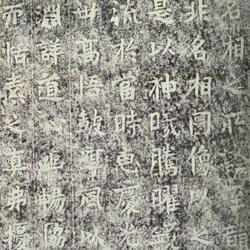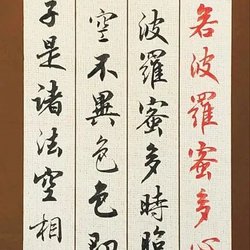"Twenty Products of Longmen" is an inscription rubbing of the twenty statues in Longmen Grottoes, and is a representative work of the calligraphy style of the Northern Wei Dynasty. "Shi Ping Gong Statue" was originally an inscription attached to the Buddhist niche. Its full name is "Bhikkhu Huicheng's late father Shi Ping Gong Statue Statue". It was carved on the north wall of Guyang Cave, Longmen, Luoyang, Henan in the 22nd year of Taihe (498), the 22nd year of Emperor Xiaowen of the Northern Wei Dynasty. . The inscription is written by Meng Da and written in regular script by Zhu Yizhang. The difference between this stele and other stele is that the entire stele is carved using the Yang carving method, with word-by-word boundaries, which is the only one seen in stone carvings in the past dynasties, and is unique among statue records. Send the content of the article The statue was made out of the religious feelings of the person who created it, and also to pray for blessings and eliminate disasters for the deceased. It was first discovered by Huang Yi (1744-1801) during the Qianlong period of the Qing Dynasty. It was valued by the calligraphy community and was included in the "Twenty Products of Longmen". The strokes are thick and full, sharp and majestic. It is regarded as the representative of the vigorous style of Wei stele's square brush.
The statue was made out of the religious feelings of the person who created it, and also to pray for blessings and eliminate disasters for the deceased. It was first discovered by Huang Yi (1744-1801) during the Qianlong period of the Qing Dynasty. It was valued by the calligraphy community and was included in the "Twenty Products of Longmen". The strokes are thick and full, sharp and majestic. It is regarded as the representative of the vigorous style of Wei stele's square brush.
Kang Youwei said that the Longmen stone carvings are "all majestic and majestic, with extremely expressive ideas and extremely regular brushwork." The "Statue of Duke Shi Ping" is a representative work among the Longmen stone carvings.
Reminder:
Qing Dynasty Yang Shoujing: "Shi Ping Gong" wins with broadness. ("Ping Stele Record")
Kang Youwei of the Qing Dynasty: It has been published in various works, and finally "Shi Ping Gong" is extremely interesting. If the bones are well formed and the body shape is stable, the body will be strong and strong, and there will be no weakness in life. ("Guangyi Zhou Shuangji")
Kang Youwei of the Qing Dynasty: "Yang Dayan", "Shi Ping Gong", "Zheng Changyou" and "Wei Lingzang" on the northern stele. They are extravagant in appearance and solemn in style, similar to the "Shou Zen Stele". ("Guangyi Zhou Shuangji")
Kang Youwei of the Qing Dynasty: After Taihe, various families emerged, and Fang Zhong published "Shi Ping Gong". ("Guangyi Zhou Shuangji")
other information
The record of the statue of Bhikkhu Huicheng of the 20th grade of Longmen - the statue niche is located on the outermost side of the second floor of Guyang Cave. It is the statue of Bhikkhu Huicheng, his late father, Shi Pinggong. The niche is 240 cm high, 185 cm wide and 46 cm deep. It is in the shape of a round arch with a pointed lintel. Eleven boys holding flower ropes are engraved on the inside of the arch. Lotus flowers are embossed between two boys, and stems and leaves are engraved in low relief. The arch system was decorated separately during the carving process, but it no longer exists. The niche pillars on both sides of the statue niche are replaced by honeysuckle patterns, two cocked dragon heads and two four-armed kings with ghosts on the ground. Buddhist niche pictures
The main Buddha in the niche is sitting in lotus position, with two Bodhisattvas on both sides of the Buddha standing beside him.
There are two different opinions on the completion time of this niche, the 12th year of Taihe and the 22nd year of Taihe. The statue is recorded on the right side of the niche, 130 cm high and 40 cm wide. This statue record is the only Yang-engraved work among the twenty products of Longmen, and it is signed by Meng Da and written by Zhu Yizhang. The inscriptions on the inscriptions are square, powerful and dense.




















